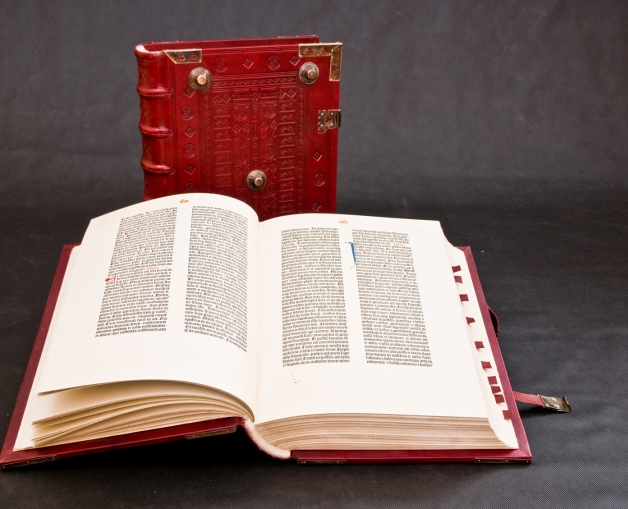The Gutenberg Bible
John Gutenberg, Gutenberg Bible, Mainz, 1452–1455
Gutenberg Bible is a landmark work in the history of mankind, and the greatest achievement of Gutenberg’s printing workshop. This is the first book in the history of the Western world are printed, bound and published in more than one original. Gutenberg Bible of the achievements of modern civilization is compiled along with the discoveries of Copernicus and Columbus.
Limited Edition: 198 copies
John Gutenberg, Gutenberg Bible, Mainz, 1452–1455
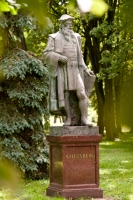 Johanes Gutenberg Statue
Johanes Gutenberg Statue
more >>
In 2000, during the celebration of the Jubilee of the 600 anniversary of John Gutenberg, to celebrate the 550th anniversary of the release of the first book containing the printed word, Publisher Diocese Pelplin "Bernardinum", along with many fans of black art, has taken to issuing facsimile “the whitest of White Ravens” - 42-line Gutenberg Bible. This project met many challenges, taught humility, gave a lot of emotion and joy. Required to carry out research and consultations, which were attended by scientists from Poland (Institute of Leather Industry, Pulp and Paper Institute) and Japan (Keio University in Tokyo). While this work was performed, many mysteries and ambiguities have been discovered and solved. After a long period of research and preparation, as a result appeared a faithful copy of the Bible, printed hundreds of years ago by a Master of Mainz. Facsimile is made using the finest of modern technologies (photography, scanning, printing plates, printing), especially for the occasion, made paper with a watermark placed as in the original, painstakingly repainted by hand initials. The Bible has been framed like a medieval workshop bookbinder in oak boards, vegetable tanned goat skin and setting decorated embossing and hardware designed in the fifteenth century. The first issue of facsimile edition of the Gutenberg Pelplin’s Bible found their buyers among collectors and investors around the world. Ten years later, in 2012, Orbis Pictus Publishing House in cooperation with the Publishing House Bernardinum presents you the latest issue of the book, ending at the same time publishing process set the total number of 198 copies of this extraordinary work.
We are pleased to present the result of our work together and as a distributor of the last 99 copies of the Bible, of which 49 will be allocated to the Polish market, and 50 to foreign, and suggest you to join the exclusive club of owners of a facsimile of the most expensive book in the world.
Cistercians and Mystic Pelplin
“This monastery, founded and equipped by the former polish Princes, Sambor, Mszczuj and Świętopełek, had buildings so formidable and decorative that it inspired awe in all people”
Jan Długosz “Twelve books on the Polish History”
tome IV, book XI
Pelplin Abbey
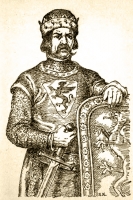 Mestwin II, Duke of Pomerania
Mestwin II, Duke of Pomerania
more >>
The history of the Pelplin abbey started with the arrival of the Cistercian order lead by the abbot Werner on 27 October Anno Domini 1276 to the Pelplin land. The “white monks” received this land under the grant of Prince Mestwin II (Mszczuj) two years prior pursuant to the document issued in Świecie.
 Pelplin in 1774
Pelplin in 1774
more >>
Cistercians – excellent administrators, farmers, builders, as well as artists and bankers – by proving excellent managers and conducting a policy that won them the support of many wealthy benefactors, they created an abbey that for over 500 years constituted an economic and cultural center that radiated to all of Pomerania. Suffice is to say that the benefactors of the abbey included Pope Nicolaus IV and King Przemysł II and King Władysław I the Elbow-high. The later Polish princes and kings honoured the privileges of the order and sustained the custom of donations and visited the Pelplin abbots (Sigismund III Vasa, Władysław IV Vasa, John III Sobieski). The Cistercians administrated the Pelplin land until the end of the 18th century when the Prussian king secularized the monastic assets, and monastic orders as such were dissolved.
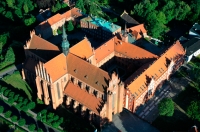 Pelplin Cathedral
Pelplin Cathedral
more >>
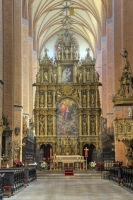 Altar
Altar
more >>
The accomplishments of the Pelplin Cistercians include the most beautiful monuments in Europe. Primarily, the Cathedral – currently holding the status of a minor basilica. Built for nearly 300 years (14th – 16th century) and fitted for an even longer period is a pearl of gothic sacral architecture. Particularly astonishing are its fittings, were styles and eras in art are harmoniously interwoven creating an exceptionally beautiful interior. The largest gilded altar east of the Pyrenees, one of the largest and most beautiful gothic stalls, various gothic aisle and transept vaults, the unique paintings of Herman Han, Andrzej Stech, beautiful baroque organs and pulpit and many unique details emphasize the sheer beauty of this temple.
The entire post-Cistercian complex is supplemented by: a beautiful gate church from the
 Cloister
Cloister
more >>
14th century, refectories, galleries, stained-glass windows, miscellaneous old manor buildings, as well as ponds and beautiful gardens. The 19th century also marks the transformation of Pelplin from a monastery settlement into an urban organism. In 1821 Pelplin became the capital of the Chełmin dioceses, and became the seat of diocesan institutions, a theological seminary, and bishop's gymnasium - Collegium Marianum. It also saw the development of the processing industry, and the rise of the first printing house.
Owing to the seminary, the city become a flourishing scientific center and a place where Polish traditions were deeply respected and cultivated, not only for Pomerania. That is why, at the turn of the 19th and 20th century, this town was dubbed the “Athens of Pomerania”.
Johannes Gutenberg
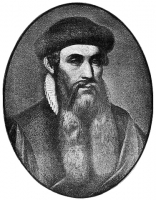 Johanes Gutenberg
Johanes Gutenberg
more >>
The man who is attributed with the invention of the first practical method of printing is Johannes Gutenberg. His brainchild is considered to be Germany’s greatest contribution to the development of civilization and every copy of the masterpiece of the typographic arts, the so-called 42-line Gutenberg Bible, is worth a fortune. Johannes Gutenberg was born in Mainz ca. 1400. In his youth he specialized in metal working and, among others, learned to engrave letters in metal. In secret, however, he was working on a new invention. Thus, the movable type, printing press and hand mould were born. Lacking funds to continue works on his invention, ca. 1450 he was forced to take out a loan from Johann Fust, a banker. Next, Gutenberg and Fust founded an enterprise – with Fust suppling capital and Gutenberg skills and professional preparation. One of the first projects of the enterprise involved publishing the Bible. At the time the book was so expensive that only a few could afford to own it. The master from Mainz wanted to print numerous identical Bibles that would be much cheaper than manuscripts, yet equally beautiful.
Throughout 1452-1452 a total of 180 copies of two-tome Bibles were created, these were printed in Latin using blackletter type, the same type used by monks to copy books. In time, the partners quarrelled which lead to a court dispute between them. By order of the court from 1455, Gutenberg was forced to return the loan and most probably lost his workshop. Fust became the owner of the printing shop and along with Gutenberg’s student, Peter Schöffer, started his own publishing operation. Gutenberg stayed in Mainz and probably remained involved in printing. He died on 3 February 1468 as a courtier of Archbishop Adolf von Nassau.
History of the Pelplin Copy the Bible
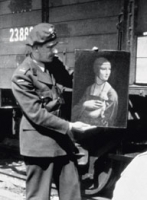 prof. Karol Estreicher
prof. Karol Estreicher
Two-tome book purchased probably by Mikołaj Chrapicki (1496–1508), the bishop of Chełmin, and donated to the Franciscans in Lubawa. After the monastery was secularized in 1833, it was transferred to the seminary library in Pelplin. Long-term studies of the director of the University Library in Königsberg and later of the Royal Library in Berlin, dr Paweł Schwenke, proved as early as 1897 that the Pelplin copy was the original 42-line Gutenberg Bible.
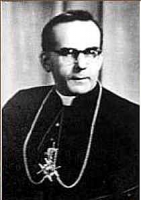 rev. Antoni Liedtke, PhD
rev. Antoni Liedtke, PhD
Prior to World War II, there was a present danger that the Bible may be lost. Its value posted a temptation to simply to sell the book and use the proceeds to refurbish the cathedral and expand the Theological Seminary building. An animated discussion in the press and protests of bibliophiles, however, thwarted these plans.
Nonetheless, a new danger loomed over the Pelplin Bible in 1939. At the time Antoni Liedtke took it out of Pelplin in a modest briefcase and secured in the vault of one of the Polish banks, wherefrom, along with other national treasures, it was transported to Paris. On the eve of the German occupation of the French Capital, prof. Karol Estreicher transported the Bible to England on small ship. After a short stay in London, on flagship “Batory” the Pelplin treasure set out on a new voyage to Canada to return to Pelplin after twenty years on 24 February 1959. The Bible, first exhibited in a special safe in the Theological Seminary, since the opening of the new building of the Diocese Museum in February 1988 remains its most treasured prize.
Description of the Pelplin Bible
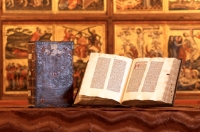 Gutenberg Bible
Gutenberg Bible
more >>
The Pelplin Gutenberg Bible is one of approximately 180 copies of the two-tome Bible printed by Gutenberg throughout 1452-1455. Currently, only 48 copies of the work of the master of the “black art” from Main survive, of which 36 on paper, 12 on parchment. Only 20 of these are complete copies. Currently 14 copies of the 15th century Bible are in Germany (including two copies from Leipzig taken to the Soviet Union in 1945), 10 – in the USA, 8 – in Great Britain, 4 – in France, 2 – in the Vatican and Spain, and 1 each in Austria, Denmark, Poland, Portugal, Belgium, Switzerland and Japan. The only copy of this “most valuable book in the world” in Poland is kept in the Bishop Stanisław Wojciech Okoniewski Diocesian Museum in Pelplin.
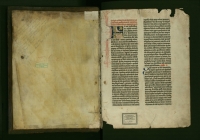 The first folio of the Gutenberg Bible
The first folio of the Gutenberg Bible
more >>
The Pelplin copy, composed of two tomes, was printed on paper and features the original 15th century binding made by the famous bookbinder, Master Henricus Coster of Lübeck. Just as the remaining copies of the Bible, also the Pelplin one has the Latin text of all Books of the Holy Bible translated by Saint Jerome, as well as comments and prologues from the Vulgate, the officially promulgated Latin version of the Bible at the time. Both tomes include 640 leaves in folio printed on both sides in two columns of the size of 285 x 85 mm, containing 40-42 lines. The Pelplin Bible is missing the last, 317th leaf in tome II, containing the text of the Apocalypse that ends on chapter XX, line 9 and two leaves(318 and 319) with no print. The initials and decorations of the Bible were handmade by a calligrapher and rubricator. Among the 149 large initials (from 3 to 6-line initials), the most beautiful one is featured on the first page of tome I made in the shape of the letter F, blue, lined with gold and a featuring an beautiful marginal decoration.
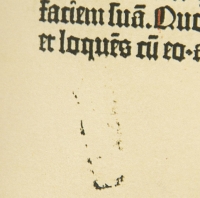 First typographical error
First typographical error
more >>
The remaining initials are two-coloured, blue and red, with a delicate feather-like decoration. Despite the fairly modest illuminations, the Pelplin Bible is among the most valuable surviving copies. This is due to its rich calligraphy and rubrications, i.e. book titles, clarifications at the beginning and end of prologues and books, incipits, explicits made in red-ink, that were not made in print to avoid excessive costs related to re-setting the folios on the press. The anonymous rubricator of the Pelplin Bible distinguishes himself with impressive independence and freedom, i.e. the Bible features significant deviations from the “Tabula rubricarum” printed by Gutenberg, which serves to increase its documentary value.
A small, yet extremely valuable detail further elevates the significance of the Pelplin copy of the Gutenberg Bible. The margin under the left column on page 46 of tome I features a 25 x 7 mm stain. This stain is an impression of the shape of the type which probably slipped out of the hands of a type-setter. This mark allows modern researcher to reconstruct Gutenberg’s type, which is of invaluable significance to printing historians.
Making of the Facsimile
Beginning
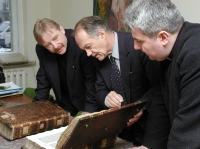 Work on the facsimile
Work on the facsimile
Plans to create a facsimile first came to light at the end of the 1970s, at the time, however, it was impossible to photograph the particular pages without tearing the binding separating the folios. Thanks to modern technology such pictures can be taken without damaging the Bible. The facsimiles of the Pelplin Bible were printed throughout 2002-2003. This coincides with other important dates: the 550th the anniversary of printing the Bible, 350th anniversary of the Higher Theological Seminary and the 10th anniversary of the foundation of the Pelplin Diocese. One special occasion is, however, the 25th anniversary of the pontificate of Polish Pope, His Holiness John Paul II.
On 7 September 2000, the Bernardinum Publishing House organized in Pelplin an event to commemorate the 600th anniversary of Gutenberg’s birth. This was an event attend by persons involved in the world of books: publishers, typographers, bookbinders and booksellers; it proved a favourable venue for signing a letter of intent concerning publishing the facsimile of the Pelplin copy of Gutenberg’s Bible, the only one in Poland. Preparations took a couple of months. The Bishop of Pelplin, His Eminence Jan Bernard Szlaga established the Facsimile Publishing Committee. Pelplin several times hosted meetings of paper manufacturers, typographers, scientists, among others, from the Pulp and Paper Institute and Leather Industry Institute from Łódź, tanners and bookbinders. Among them, they discussed the necessity of conducting scientific research prior to working on the facsimile. Later the experts determined the composition of the paper, placement of watermarks, manner of facsimileing the folios of the Bible and binding modelled after the work of Master Coster of Lübeck.
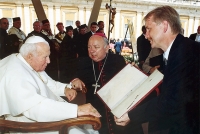 Pope John Paul II receives copy no. 1 of the facsimile
Pope John Paul II receives copy no. 1 of the facsimile
more >>
The publishers’ goal was to create a faithful copy of Gutenberg’s work. It was agreed that the Bible would be issued in two tomes and its circulation would be similar to Gutenberg’s original print-run of 198 numbered copies. Since 2002, 98 copies were issued, and exactly 10 years later, in 2012 Orbis Pictus presents to you the last print-run of 99 copies of the masterpiece.
“The Pelplin copy, printed on paper, in two tomes, survives in a pretty good condition, though it was slightly damaged due to former humidity, which caused crumbling especially in the upper edges of leaves, and even causing some red-ink headers to smudge. The print exhibits the initial freshness and gloss of shining black and the strong vat paper with a yellow-grey tint and four different watermarks is preserved in a very good condition.”
Rev. Antoni Liedtke, PhD “Saga of the Pelplin Gutenberg Bible” (Pelplin 1987)
Paper and Watermarks
Today we know that Johannes Gutenberg probably purchased the paper to print the Bible in the paper mills of Strasburg and Piedmont, as evidenced by the watermarks used to sign each leave of vat paper by the mills.
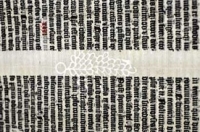 Watermark / photo by Jakub Szymczuk, Agencja GN
Watermark / photo by Jakub Szymczuk, Agencja GN
The Pelplin copy of the Bible contains four watermarks. These present the head of an ox, the full silhouette of an ox, and a bunch of grapes of two types. Watermarks are featured on nearly all folios. The paper used in the original is 0.21-029 mm thick. As the facsimile is printed using offset printing, it was necessary to produce a paper with similar parameters as the original. Ultimately, a thickness of 0.23 mm (this is the average from 10 folios of the Bible) and a grammage of 140 g/m2 were assumed. The conditions set before the excellent paper mill, the Polish Security Printing Works in Warsaw, included not only the above technical parameters, but also a unique manufacturing technology, special dyeing and fluffing imitating vat paper.
It was also important that the folios be watermarked as per the identifying documentation pertaining to the original. The facsimile faithfully reproduces the watermarks from the original copy of the Bible. The cellulose used to prepare the paper pulp was produced by the “International Paper” paper mill from Kwidzyń.
Photographing
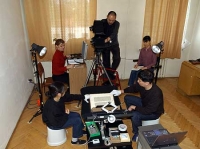 Photographing the Bible in 2002
Photographing the Bible in 2002
The impact of the photographing process on the Bible and the achieved quality are the main factors that determined our selection of reproduction techniques. Our task was to choose a technology to limit the angle of dilating the sewn and bounded folios of volumes and the impact of such factor as light and humidity during exposure. After many trials, among others, using the latest 2iS scanner for digitizing old prints provided by XEROX Poland and after long consultations among specialist, it was decided to cooperate with the scientists of the Keio University in Tokio, co-creators of the HUMI project, who earlier digitized copies of the Bible from Tokio, Mainz and Cambridge.
In 2001, after a preliminary visit from the representatives of the Keio University and subsequent arrangements with the project manager, professor Toshiyuki Takamiya, in May 2002 Pelplin was visited by a group of scientists from Japan equipped with specialistic equipment (among other, analogue camera of the Swiss company Sinar with Schneider optics with numerous peripheral devices – in total approximately 500 kg of equipment!). The works which took place on the premises of the Bernardinum Publishing House in a dedicated room with the appropriate temperature and humidity were directed by Masaaki Kashimura. Three weeks of intensive works generated over 1500 exposures made on large-format, 4 x 5” Kodak diapositives. In the photographing process, the working group ensured all security measures protecting against the negative impact of external factors and systems of controlling the quality of diapositives along with an internet connection with the Keio University in Tokio that allowed for the comparison of results with prior digitization of other copies of the Bible. The chemical and photo processing of photographs (developing diapoisitives) was the responsibility of TCF s.c. from Gdańsk.
Scanning and Making Printing Formes
1281 scans, their graphical processing and 1127 kilograms of printing formes made in CtP technology represent the workload dedicated to prepress preparation of just one work.
The preliminary works consisted in making precise spectrophotometric measurements of the original to setup the proper ICC profile required to start the proper process of scanning, taking into account the color of the paper used to print the facsimile. Scanned computer images were printed using a digital proofer on the target paper. Based on spectromorphic measurements of these print-outs, the final correction of the ICC profile was made. The next step involved making the final test in the Pelplin printing house, on an offset printer, using the selected materials (paper and inks). Rescanned test pages (using the corrected ICC profile) were then exposed directly to offset plates. The electronic image was subject to further processing on graphics workstations. Its purpose was to correct pages against foreshortening caused be the natural curve of pages during opening such a thick book and meticulous removal of all unnatural defects on the slides.
Ready pages were then electronically arranged and exposed on printing plates using the latest CtP technology. This technology, owing to the direct output of the computer image to printing plates (omitting the process of making films) guarantees high quality of raster points on printing formes and thereby the highest quality of the final print. Digitizing the photographic materials, graphic processing and exposing printing plates in CtP technology was entrusted to DjaF from Cracow.
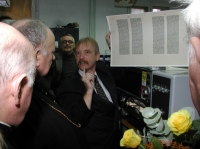 First Prints
First Prints
more >>
All masterpieces, and one such is the facsimile editions of Gutenberg’s Bible, require the best technologies and cutting-edge machines and equipment. To meet this challenge, the printing shop of the publishing house, owing to the assistance and kindness of Mercator, a company from Cracow, obtained the Shinohara 74 IV, a four-colour offset press. The parameters and capabilities of this Japanese machine, in conjunction with CIP 3 software, ensured that over 320 printed folios of the facsimile of the Master from Mainz faithfully reflect the image of the original. The printing activities as part of this task, were facilitated by peripheral devices supplied by Huber Polska: SpectroEye spectrometer and iC Plate Gretag used to control the parameters of prints and study the raster point of offset forms. Excellent fidelity of colors, color intensity achieved in the printing process was possible owing to using this company’s inks.
The black ink was made according to a special recipe drafted on the basis of colorimetric studies over the original copy of the Bible, adapted to the properties of the paper used to print the facsimile to fully reflect the contour and black intensity of text elements.
Painting and Gilding
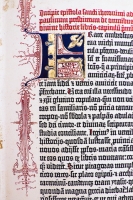 Gold-plated Initial
Gold-plated Initial
more >>
All initials and decorations made earlier by an illuminator, have been painted over by hand in the reprint. Initials are two-coloured, blue and red, with a delicate feather-like ornament. These ornaments were painted using very fine brushes size 000, and corrected carefully and with great reverence.
During the painting process, it turned out that the illuminator was probably left-handed, as only left-handed persons could successfully correct the spiral ornament. The most beautiful of the 144 initials is the first, blue one featured on the first page of tome I shaped as the letter “F”. It was additionally hand-decorated with a marginal ornament and gilded with 24-carat flake gold on the appropriate ground coat and agate-polished.
The technique used to decorate the leaves, just as in the case of the binding, is no different than the one used in medieval scriptoria.
Binding
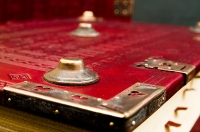 Binding
Binding
more >>
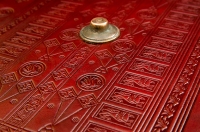 Binding - Stamping
Binding - Stamping
more >>
The binding of the facsimile is a faithful copy of the one made by Henricus Coster of Lübeck in the 15th century. It is composed of two oak boards dressed in red skin and for greater durability fitted with brass studs, corners and clasps on leather straps used to close the Bible.
The rich ornament of the external lining with stamped numerous figural, floral and animal motives in a beautiful geometric arrangement whose middle square features the most beautiful ornament is signed in the upper and lower strap with two stamps i.e.: “hin(ri)c(us) cost(er)” and „bant dit”, which constitute the confirmation of authorship of the medieval binding. The binding has no protective leaves, and the internal side of the lining is lined with calfskin parchment.
The volume block is sewn with linen string, with natural threads. This sewing creates natural binds on the spine of the binding which is built on the Bible block. Goatskin used in the binding was vegetable-tanned. The technology of tanning leather using natural ingredients from the 15th century was recreated on special order.
Extraordinary Packaging of the Gutenberg Bible Facsimile
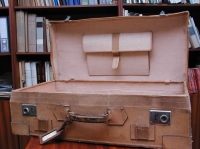 Original Suitcase
Original Suitcase
more >>
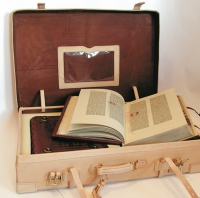 Recreated Suitcase
Recreated Suitcase
more >>
A great expert on Gutenberg and his work, pastor Don Cleveland Norman, considers that the wartime history of the Pelplin copy of the Bible would be an excellent script for a thriller. It all started at the beginning of the summer of 1939 on the eve of the outbreak of World War II. The art conservator of the Chełmin Diocese at the time, rev. Antoni Liedtke, in light of the looming threat took efforts to save the most valuable Pelplin pieces of art against loss and destruction. Obviously, priority was given to the Gutenberg Bible.
In his book, “Saga of the Pelplin Gutenberg Bible”, rev. Liedtke writes: “Authorized by the bishop ordinary (Stanisław Wojciech Okoniewski) to secure the Bible, I prepared a packaging to fit the journey in the form of a strong leather briefcase ordered in utmost secrecy with the local leatherworker, Teodor Gutkowski. In the briefcase, apart from both tomes of the Bible, I also placed the most valuable manuscript in our possession, the “Psalter from the Czech school from the beginning of the 16th century and a copy of my work entitled “The Gutenberg Bible in Pelplin” published in Toruń in 1936.”
In this extraordinary packaging on 1 August 1939 the Bible embarked on its wartime wander which was described in the section devoted to the history of the Pelplin copy of the Bible. The briefcase housing the facisimile of the Pelplin copy of the Gutenberg bible is an exact replica of the packaging made in the spring of 1939.
Specification
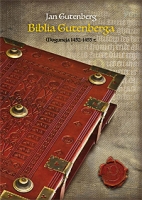
Johannes Gutenberg, Gutenberg Bible, Mainz, 1452–1455
Dimensions: two tomes, 315 x 430 x 115 mm each
Number of leaves: 640
Paper: 140 g/m2, customer-dyed and fluffed, imitating vat paper, with watermarks as in the original
Binding: oak boards dressed in red leather, brass studs, corners and clasps fitted on leather straps, (binding - in this case packing- could be different from what you see on the pictures)
Packaging: leather briefcase, replica of the original packaging of 1939; dimensions: 540 x 790 x 200 mm
Limited print-run: 198 copies. Available: less than 96 copies
Official dealer: Orbis Pictus Publishing House
Publisher: Bernardinum Publishing House of the Pelplin Diocese


